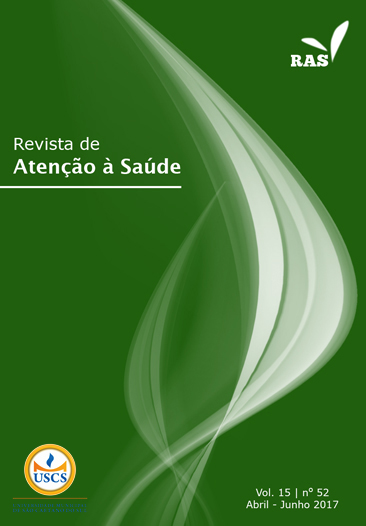Oral health: knowledge and importance for pregnant women
DOI:
https://doi.org/10.13037/ras.vol15n52.4518Keywords:
Oral health, Gestation, Nursing in community healthAbstract
Introduction: During gestation, physiological, hormonal, psychological and behavioral changes may affect the mother’s oral health, interfering with the baby’s health. Objective: To characterize the knowledge of pregnant women, about different aspects of oral health, accompanied by Nursing. Materials and methods: Descriptive, prospective and quantitative study with 32 pregnant women attended at a Basic Family Health Unity in a city Ceará. The data were analyzed, interpreted and described. Results: The majority of the population consisted of pregnant of legal age, married, with schooling varying between incomplete elementary and higher education and income of up to three minimum wages. Of the participants, 68.7% didn’t know the diseases that reach the oral cavity and all used brush and toothpaste. Regarding preventive measures, 75% of pregnant indicated brushing and flossing, and 43.7% mentioned a search by the dentist. Of the total, 53.1% had gingival bleeding on toothbrushing and 59.4% had already participated in Health Education actions, performed especially by the dentist. Regarding the relationship among pregnancy, maternal oral health and baby health, the majority of pregnant was aware. Correct baby oral hygiene practices were pointed out by 90% of those surveyed, 68.7% mentioned the eruption of the first tooth as an ideal moment to take the baby to the first dental appointment, and 87.5% presented a cariogenic diet. Conclusions: Most pregnant were unaware of diseases that reach the oral cavity, but they knew how to avoid them. They were aware of the relationship among pregnancy, maternal oral health and baby health.
Downloads
References
1. World Health Organization. Preamble to the Constitution of the World Health Organization as adopted by the International Health Conference, New York, 19-22, June 1946, and entered into force on 7 April 1948.
2. Wadhawan R, Solanki G, Sabir S, Palekar S, Pareekh A. Oral manifestations of systemic diseases: a review. Journal of Science. 2014;4(4):233-41.
3. Onigbinde OO, Sorunke ME, Braimoh MO, Adeniyi AO. Periodontal status and some variables among pregnant women
in a Nigeria tertiary institution. Ann Med Saúde Sci Res. 2014;4(6):852-7. 4. Wu M, Chen SW, Jiang SY. Relationship between gingival
inflammation and pregnancy. Mediators Inflamm. 2015;2015:1-11.
5. Moyer VA. Prevention of dental caries in children from birth through age 5 years: us preventive services task force recommendation statement. Pediatrics. 2014;133(6):1-10.
6. Oliveira LB, Moreira RS, Reis SCGB, Freire MCM. Cárie dentária em escolares de 12 anos: análise multinível dos fatores individuais e do ambiente escolar em Goiânia. Rev Bras Epidemiol. 2015;18(3):642-54.
7. Ramos ESM, Martins NR, Kroumpouzos G. Oral and vulvovaginal changes in pregnancy. Clin Dermatol. 2016;34(3):353-8.
8. Umoh AO, Savage KO, Ojehanon PI. Association between maternal gingivitis, low birth weight and preterm delivery.
JMBR.2013;12(1):65-75.
9. Albornoz AC, Figuero E, Herrera D, Martínez AB. Gingival changes during pregnancy: II. Influence of hormonal variations on the subgingival biofilm. J Clin Periodontol. 2010;37(3):230–40.
10. Zi MYH, Longo PL, Silva BB, Mayer MPA. Mechanisms involved in the association between periodontitis and complications in pregnancy. Front Public Health. 2014;2:290.
11. Araújo MVM, Vieira MA, Bonan PRF, Costa SM. Atuação dos profissionais de enfermagem nos cuidados com a higiene bucal de idosos institucionalizados em montes claros –MG. Rev APS. 2010;13(1):10-7.
12. Hartnett E, Haber J, Miller KB, Bella A, Vasilyeva A, Kessler JL. Oral Health in Pregnancy. J Obstet Gynecol Neonatal Nurs. 2016;45:565–73.
13. Lopes FF, Ribeiro TV, Fernandes DB, Calixto NRV, Alves CMC, Pereira ALA, et al. Oral health knowledge and practices among pregnant women using health services in São Luís, Maranhão, Brazil, 2007-2008. Epidemiol Serv Saúde. 2016;25(4):819-26.
14. Eke PI, Dye BA, Wei L, Slade GD, Evans GOT, Borgnakke WS, et al. Update on Prevalence of Periodontitis in Adults in the United States: NHANES 2009 to 2012. J Periodontol. 2015;86(5):611–22.
15. George A, Johnson M, Blinkhorn A, Ajwani S, Bhole S, Yeo A, et al. The oral health status, practices and knowledge of pregnant women in south-western Sydney. Aust Dent J. 2013;58(1):26-33.
16. Barros MAR, Nicolau AIO. Fatores socioeconômicos da gestante associados ao peso do recém-nascido. Rev enferm UFPE on line. 2013;7(7):4769-74.
17. Gonik B, Wilson E, Mayberry M, Joarder BY. Pregnant Patient Knowledge and Behavior Regarding Perinatal Oral Health. Am J Perinatol. 2016;34(7):663-667.
18. Kubo FMM, Mialhe FL. Fio dental: da dificuldade ao êxito na remoção do biofilme interproximal. Arq Odontol. 2011;47(1):51-5.
19. Silva EM, Filho CE, Nepomuceno VC. Uma grande descoberta: O prazer que a higienização bucal correta e bem orientada pode proporcionar. Rev Odontológica de Araçatuba. 2003;24(2):39-42.
20. Srinivas SR, Singhal R, Kaur N. Causes for non-usage of floss among students in a dental institution in North India: A questionnaire study. PROBE. 2014;48(3):109-14.
21. Riggs E, Yelland J, Shankumar R, Kilpatrick N. We are all scared for the baby: promoting access to dental services for refugee background women during pregnancy. BMC Pregnancy Childbirth. 2016;16(12):1-11.
22. Asa’ad FA, Rahman G, Mahmoud N, Shamasi E, Khuwaileidi A. Periodontal disease awareness among pregnant women in the central and eastern regions of Saudi Arabia. J Investig Clin Dent. 2015;6(1):8-15.
23. Castilho ARF, Mialhe FL, Barbosa TS, Puppin-Rontani RM. Influence of Family environment on children’s oral health: a systematic review. J Pediatr (Rio J). 2013;89(2):116-23
24. Malkawi ZA, Tubaishat RS. Knowledge, practice and utilization of dental services among pregnant women in the north of Jordan. J Contemp Dent Pract. 2014;15(3):345-51.
25. Bamanikar S, Kee LK. Knowledge, attitude and practice of oral and dental healthcare in pregnant women. Oman Med J. 2013;28(4):288-91.
26. Thomas NJ, Middleton PF, Crowther CA. Oral and dental health care practices in pregnant women in Australia: a postnatal survey. BMC Pregnancy Childbirth. 2008;8(13):1-6.
27. Rakchanok N, Amporn D, Yoshida Y, Harun-Or-Rashid M, Sakamoto J. Dental caries and gingivitis among pregnant and non-pregnant women in Chiang Mai, Thailand. Nagoya J Med Sci. 2010;72(1–2):43-50.
28. Barak S, Oettinger-Barak O, Oettinger M, Machtei EE, Peled M, Ohel G. Common oral manifestations during pregnancy: a review. Obstet Gynecol Surv. 2003;58(9):624–8.
29. Pitiphat W, Joshipura KJ, Gillman MW, Williams PL, Douglass CW, Rich-Edwards JW. Maternal periodontitis and adverse pregnancy outcomes. Community Dent Oral Epidemiol. 2008;36(1):3-11.
30. Saddki N, Bachok N, Hussain NHN, Zainudin SLA, Sosroseno W. The association between maternal periodontitis and low birth weight infants among Malay women. Community Dent Oral Epidemiol. 2008;36(4):296–304.
31. Venancio EQ, Paula EMQV, Imada SR, Reis CB. A percepção do enfermeiro da saúde da família sobre saúde bucal na gestação. Ciênc Cuid Saúde. 2011;10(4):812-9.
32. Sharif S, Saddki N, Yusoff A. Knowledge and Attitude of Medical Nurses toward Oral Health and Oral Health Care of Pregnant Women. Malays J Med Sci. 2016;23(1):63-71.
33. Wapniarska K, Bu?a K, Hilt A. Parent’s pro-health awareness concerning oral health of their children in the light of survey research. Przegl Epidemiol. 2016;70(1):59-63.
34. American Academy of Pediatric Dentistry. Guideline on infant oral health care. Clin Pract Guidel Quick Ref Guide Clin. 2014;37(6):146-50.
35. Nada M, Dragan T, Bojana K. Nutritional analysis in women during pregnancy. Researches Review DGTH. 2015;44(2),183-93.
Downloads
Published
Issue
Section
License
Copyright (c) 2017 Francisco Cezanildo Silva Benedito, Davide Carlos Joaquim, Ana Gesselena da Silva Farias, Edmara Chaves Costa, Erika Helena Salles de Brito, Ana Caroline Rocha de Melo Leite

This work is licensed under a Creative Commons Attribution-NonCommercial-NoDerivatives 4.0 International License.
Policy Proposal for Journals offering Free Delayed Access
Authors who publish in this magazine agree to the following terms:
- Authors maintain the copyright and grant the journal the right to the first publication, with the work simultaneously licensed under a Creative Commons Attribution License after publication, allowing the sharing of the work with recognition of the authorship of the work and initial publication in this journal.
- Authors are authorized to assume additional contracts separately, for non-exclusive distribution of the version of the work published in this magazine (eg, publishing in institutional repository or as a book chapter), with the acknowledgment of the authorship and initial publication in this journal.
- Authors are allowed and encouraged to publish and distribute their work online (eg in institutional repositories or on their personal page) at any point before or during the editorial process, as this can generate productive changes, as well as increase impact and citation of the published work (See The Effect of Open Access).









